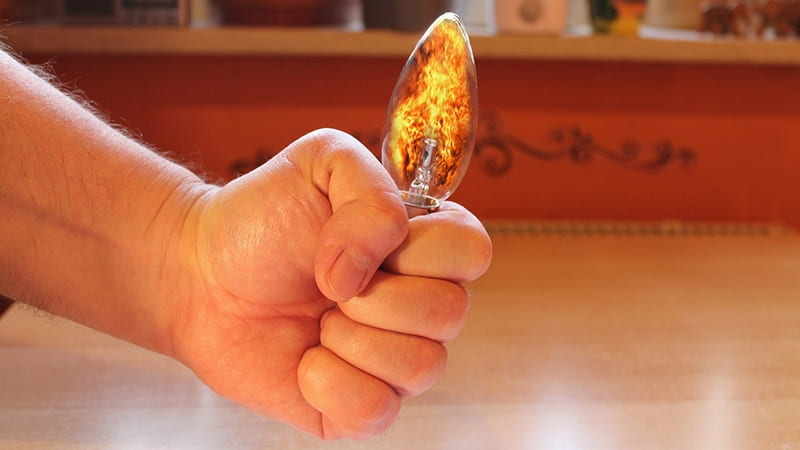THERMOELECTRICS: HARVESTING ENERGY FROM HEAT
By: Puikei Cheng

Image credit: Pixabay; used under Creative Commons.
The discovery of fire was a turning point in human history for many reasons. Fire offered portable warmth, light, protection, and a new way of preparing food. It was also one of mankind’s most successful attempts to harness energy. Other major efforts include the water wheel, the steam engine, and the combustion engine—all of which convert energy from one form to another. For example, ancient water mills converted kinetic energy from flowing water into kinetic energy for grinding grain.
Modern water wheels are more sophisticated and efficient. Instead of turning wheels, hydroelectric power plants use turbines to convert kinetic energy from waterfalls into mechanical energy, which a generator then converts into stored electrical energy. Technological advancements like turbines, generators, and batteries helped propel the world into the age of ubiquitous electricity. Further breakthroughs in electrical storage and transmittance have made household electricity as common as running water.
Despite how universal energy conversions are, energy is almost always lost in the process. Some processes lose more than others. Electricity is considered high-grade energy because it can be converted into other forms of energy for use and storage without significant losses. Thermal energy lies on the opposite end of the spectrum. It is low-grade energy, which means that attempts to transform heat back into other forms of energy are typically costly and relatively inefficient. (The most notable exception, geothermal heating, is only an option in certain regions of the globe.) Most of the time, thermal energy is written off as waste heat and released into the environment without further ado.

Jonathan Pfluger
But scientists, like Jonathan Pfluger, are working on converting thermal energy back into high-grade energy. Pfluger is a graduate student in the Wolverton lab at Northwestern University. According to Pfluger, he works “at the intersection of computer science, quantum mechanics, and energy materials.” He is part of a large-scale collaborative effort at Northwestern to design and improve upon material systems and energy conversion using the power of computers.
Pfluger works on thermoelectrics: materials with a curious link between the thermal and electric realms. By connecting a battery to a block of thermoelectric material (applying a voltage difference), the block will produce a temperature gradient: one side will grow warmer than the other. Conversely, heating up or cooling down one end of the block (applying a thermal gradient) will cause the block to produce an electrical voltage difference. By adding heat, the block can now act as a battery. Imagine the potential of thermoelectric-powered devices—one could charge a cell phone by using just body heat.
The problem is, natural thermoelectric materials are very rare. Instead, Plfuger and his collaborators are designing man-made thermoelectrics. “We’re looking for materials with high electron-conductivity and low thermal-conductivity,” Pfluger says. Researchers often start with a material which naturally exhibits one of these properties and try to “dope” it with impurities to increase the strength of the other characteristic. In a synthesis lab however, researchers can test thousands of different chemical combinations before finding one that shows promise. These attempts are costly in time and effort.
To speed up the search process, Pfluger uses the power of supercomputers to seek out promising thermoelectric chemical combinations. The complex physics of atoms makes it almost impossible to calculate by hand the electron conductivity and thermal conductivity of a chosen chemical combination. But supercomputers can. Once programed correctly, the supercomputers can perform extremely computationally-intensive simulations on the time and spatial scale of atoms. With powerful computers, Pfluger and other computational researchers can simulate subatomic particles a billion times smaller than the width a human hair and atomic processes and interactions a billion times faster than the blink of an eye.
Pfluger’s simulations can take days to run, but they are faster than creating physical samples of each material candidate in a lab and characterizing their properties with complicated equipment, as Pfluger’s collaborators do. At the same time, simulation results must be always verified with experiments. Therefore, Pfluger’s computational work goes hand-in-hand with his collaborator’s lab experiments. “We sort of have a heated battle going on,” he laughs. “We’re seeing who can work faster.”
Pfluger is cognizant that his research has its limits. Looking ahead, he notes that “the avenue is rocky. Making materials efficient enough to capture even 20% of total heat lost is hard.” Plus, the majority of known thermoelectrics are most efficient at temperatures above 300°C. Since humans operate at about 37°C and car engines at about 100°C, installing current energy-harvesting thermoelectrics on cars or people is impractical. However, low-efficiency thermoelectric materials are becoming increasingly common in larger industrial applications like sensors, coolers, and waste energy recycling.
Converting low-grade energy back into high-grade energy is an uphill battle. But there are new products which run on electricity every day, and thermoelectric products could have very unique features to offer. With a little help from the electricity powering their supercomputers, researchers like Pfluger can seek out future thermoelectric materials for applications that engineers today can only dream about.
This feature stems from an interviewing assignment in Science and Society’s Skills & Careers in Science Writing course. Graduate student scientists interview each other and write-up their colleagues’ work and select pieces are published on HELIX.
